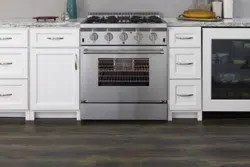Loading ...
Loading ...
Loading ...

18
INSTALLATION
Check the appliance is electrically safe and gas sound when you have nished.
Gas Connection
Installation of this range must conform with local codes or, in
the absence of local codes, with the National Fuel Gas Code,
ANSI Z223.1-latest edition.
In Canada
The range must be installed in accordance with the current
CGA Standard CAN/CGA-B149 – Installation Codes for Gas
Burning Appliances and Equipment and/or local codes.
In The Commonwealth Of Massachusetts
This product must be installed by a licensed plumber or
gas tter when installed within the Commonwealth of
Massachusetts.
A “T” handle type manual gas valve must be installed in
the gas supply line to this appliance, in an easily accessible
location, outside the range. This is for the purpose of easily
turning on or shutting o the gas supply to the appliance.
Gas Supply Requirements
Provide Adequate Gas Supply
Before installation, ensure that the local distribution
conditions (nature of the gas and gas pressure) and the
adjustment of the appliance are compatible.
The range is designed to operate at a manifold pressure of 5’’
of water column (1.25 kPa) on natural gas. A conversion kit for
LP gas (Propane) is supplied with the range. When converted
to LP gas, a pressure of 10’’ of water column (2.49 kPa) is
required.
Make sure you are supplying your range with the correct type
of gas.
If the range is to be used on LP gas, a qualied LP installer
must convert it. We recommend that the range be converted
before installation. This must be done before the range can
be used on LP gas.
For proper operation, the pressure of natural gas supplied to
the regulator must be between 4½’’ and 13’’ of water column
(1.12–3.24 kPa).
For LP gas, the pressure supplied must be between 10’’ and
13’’ of water column (2.49–3.24 kPa).
When checking for proper operation of the regulator, the
inlet pressure must be at least 1’’ (0.25 kPa) greater than the
operating (manifold) pressure as given above.
The pressure regulator located at the inlet of the range
manifold must remain in the supply line regardless of
whether natural or LP gas is being used.
A exible metal appliance connector used to connect the
range to the gas supply line should have an I.D. of ½’’ and be
5 feet in length for ease of installation.
Connect the Range to the Gas Supply
Shut o the main gas supply valve before disconnecting the
old range and leave it o until the new hookup has been
completed. Don’t forget to relight the pilot on other gas
appliances when you turn the gas back on.
Because hard piping restricts movement of the range, the
use of a CSA International-certied exible metal appliance
connector is recommended unless local codes require a hard-
piped connection.
Never use an old connector when installing a new range.
If the hard piping method is used, you must carefully align
the pipe; the range cannot be moved after the connection is
made.
To prevent gas leaks, put pipe joint compound on, or wrap
pipe thread tape with Teon* around, all male (external) pipe
threads.
A. Install a manual gas line shut-o valve in the gas line in
an easily accessed location outside of the range. Make
sure everyone operating the range knows where and
how to shut o the gas supply to the range.
B. Install a male ½’’ (1.5 cm) are union adapter to the ½’’
(1.5 cm) NPT internal thread elbow at inlet of regulator.
Use a backup wrench on the regulator tting to avoid
damage.
C. Install male ½’’ (1.5 cm) or ¾’’ (2 cm) are union adapter
to the NPT internal thread of the manual shut-o valve,
taking care to backup the shut-o valve to keep it from
turning.
D. Connect exible metal appliance connector to the
adapter on the range. Position the range to permit
connection at the shut-o valve.
E. When all connections have been made, make sure
all range controls are in the o position and turn on
the main gas supply valve. Use a liquid leak detector
at all joints and connections to check for leaks in the
system. Use a product specically manufactured for
leak detection. Leak testing of the appliance shall
be conducted in accordance to the manufacturer’s
instructions.
n
DO NOT use a ame to check for gas leaks.
When using test pressures greater than ½ psig (3.5 kPa)
to pressure test the gas supply system of the residence,
disconnect the range and individual shut-o valve from
the gas supply piping. When using test pressures of ½ psig
(3.5 kPa) or less to test the gas supply system, simply
isolate the range from the gas supply system by closing the
individual shut-o valve.
Flexible Connector
Installer: Inform the consumer of the location of the gas
shut-o valve.
Seal the Openings
Seal any openings in the wall behind the range and in the
oor under the range when hookups are completed.
IMPORTANT: When all connections are completed make
sure the ow of combustion and ventilation air to the range
is unobstructed.
Loading ...
Loading ...
Loading ...
